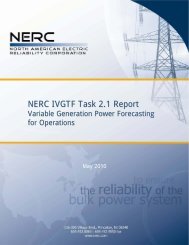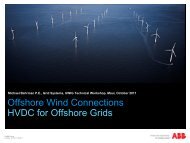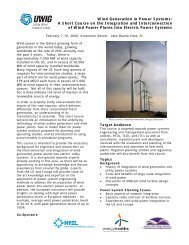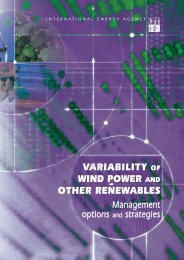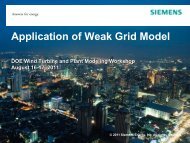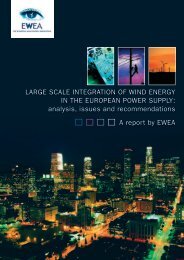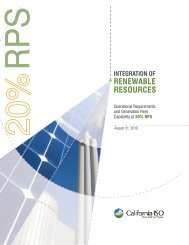Integrating Southwest Power Pool Wind to Southeast Electricity ...
Integrating Southwest Power Pool Wind to Southeast Electricity ...
Integrating Southwest Power Pool Wind to Southeast Electricity ...
Create successful ePaper yourself
Turn your PDF publications into a flip-book with our unique Google optimized e-Paper software.
It should be noted that, for Scenario 1, there are about 350 hours for which the UPLAN model<br />
finds there is not enough available regulating capacity <strong>to</strong> ensure regulation requirements are met.<br />
The shortage does not occur because insufficient regulating capacity exists, but rather because<br />
the UPLAN solution prioritizes some regulating units for providing energy under the tight<br />
system conditions where SPP is carrying all within-hour reserves. While in reality, the system<br />
would be able <strong>to</strong> operate out of this relatively easily by bringing additional “non-regulating”<br />
units online <strong>to</strong> free up regulating capacity, the model places more of a premium on meeting<br />
energy requirements at low cost and therefore does not meet regulation requirements for these<br />
hours in Scenario #1 and a smaller number of hours in Scenario #2. This is summarized in Table<br />
5-9. For Scenarios 3 and 4 this does not happen. As can be seen, this is relatively small in<br />
comparison <strong>to</strong> system size, however it does indicate that SPP would have <strong>to</strong> operate its system<br />
very tightly if it had <strong>to</strong> meet regulation requirements <strong>to</strong> balance wind by itself. For some hours of<br />
the year, the opera<strong>to</strong>rs may find themselves needing <strong>to</strong> move units out of merit <strong>to</strong> provide<br />
regulation.<br />
Table 5-9: Regulation requirement violations for SPP<br />
# Violations Avg (MW) MWh Max (MW)<br />
Scenario 1 352 285 100548 984<br />
Scenario 2 41 193 7942 541<br />
Increase in SC 1 311 92 92606 443<br />
Scen. #3 vs. Scen. #2 – Benefits of Sharing Scheduling and Reserve<br />
Requirements<br />
Relative <strong>to</strong> Scenario #2, Scenario #3 is modeled such that SPP, TVA, SBA, and Entergy share<br />
resources for scheduling day-ahead and share contingency and with-in-hour reserve requirements<br />
for the wind. As noted in chapter 3, this allows for a significant reduction in <strong>to</strong>tal reserve carried<br />
due <strong>to</strong> load and wind diversity and reduced contingency requirements. Regulation decreases 200<br />
MW and spin reduces 1900 MW due <strong>to</strong> the contingency reserve reduction. This reduction in<br />
reserve and sharing of resources in the day-ahead commitment leads <strong>to</strong> the larger differences in<br />
production cost results described previously.<br />
Table 5-10: Difference** in Generation for Scenario 3 vs. Scenario 2<br />
Change in<br />
SERC SERC<br />
GW EES TVA SBA SPP West East Total<br />
CC 0.03 (1.00) (1.41) (0.03) 0.00 0.05 (2.37)<br />
GT 0.00 (0.26) (0.03) (0.02) 0.09 0.07 (0.15)<br />
Hydro - - - - - - -<br />
Nuclear 0.00 - - 0.00 - (0.00) 0.00<br />
Coal 0.03 0.50 0.47 0.62 0.50 0.32 2.45<br />
Gasoil (0.06) - (0.00) (0.00) - 0.00 (0.06)<br />
<strong>Wind</strong> - - - - - - -<br />
Other 0.01 0.01 0.05 0.02 (0.01) 0.04 0.12<br />
Total 0.01 (0.75) (0.93) 0.60 0.58 0.48 (0.00)<br />
**Positive value represents increase in generation in Scenario #3 relative <strong>to</strong> Scenario #2.<br />
5-16




